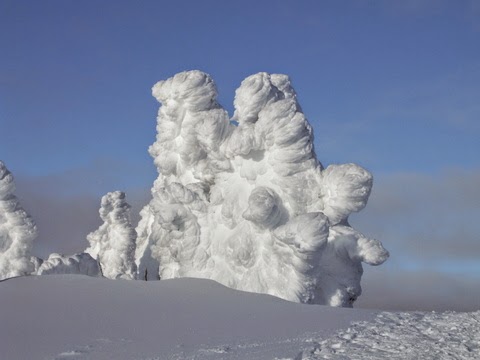During the past
summer I received some pamphlets from Elan about their new shape of skis. The
top surface on the back half of the ski is concave and on the front half is
convex. From an engineering point of
view I am not sure what these shapes can do better than a standard rectangle
cross section. Elan was one of the first
skis with the parabolic shaped sides that changed the way we ski and made
turning skis much easier. So when they
bring out a new idea it is worth taking a look at. My wave skis from Elan, that I like a lot,
baffles me because I can’t see what the wavy surface does.
When laminate skis
first came out many years ago all the engineering test data was given in the
ads. For a mechanical engineer this was
wonderful stuff. Pictures of the ski
cross section showed all the laminated layers.
Diagrams showed the bending characteristic and some show the dynamic
behavior. You could compare skis just by
looking at the data. Unfortunately this added information confused more than helped and this practice of telling you what
you were buying died out.
Ski
manufacturers now have many options in terms of material and ski shape. The odds are good that you can find skis that you will like. The trend over the last few year is less camber.
What is the effect of low camber or rocker? It
effectively shortens the ski contact edge on the snow. This causes a sort of barrel stave shape in
the snow. If you work it right there is
enough stiffness under the foot so that you can still have enough edge for grip
on ice. My guess is that a low soft camber gives you less fore and aft stability
and a slower ski. My impression is that low cambered ski is like a shortie ski
with higher flotation characteristics. It can also be super fast turning. I saw a kid last year just standing line, counter
rotating his skis. Normally this is
almost impossible on cambered skis.
 Skis with camber when
laying on a flat surface will have some space under the bindings. When
you step into a ski with camber it will flatten out and look like it has no
camber. What happens depends on the ski stiffness along the length front and
back from the boot and bindings. When loaded my
Elans, appear to be stiffer in the front and parabolic in shape, while the back
seem to be softer and circular in shape . The snow in turn is loaded heavily under the
foot tapering off gradually towards the tip and tail. You can see the short flat sections in front of toe and heel pieces and the softer ends.
Skis with camber when
laying on a flat surface will have some space under the bindings. When
you step into a ski with camber it will flatten out and look like it has no
camber. What happens depends on the ski stiffness along the length front and
back from the boot and bindings. When loaded my
Elans, appear to be stiffer in the front and parabolic in shape, while the back
seem to be softer and circular in shape . The snow in turn is loaded heavily under the
foot tapering off gradually towards the tip and tail. You can see the short flat sections in front of toe and heel pieces and the softer ends.
First you should know
that changing the thickness of the ski a little bit can make the ski either very
stiff or very soft. The math equation
included the thickness T cubed (T³). This applies to the also the high strength
material on the top and the bottom of the ski.
By changing the thicknesses and material along the length, a ski can be
made to flex and twist to any requirement.
Normally I ski on 165
to 170 cm skis but last year I used some 150 cm skis donated to the Disabled Club. I was
surprised how well they worked even in deep snow.
My thoughts are when buying a ski try several
different makes. When you find one you
like then try a size shorter and a size longer to get the best characteristic
for you.











